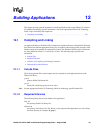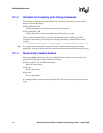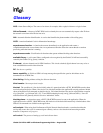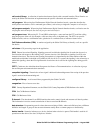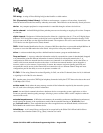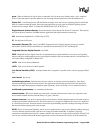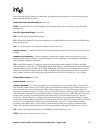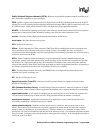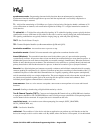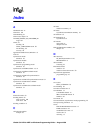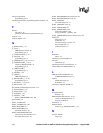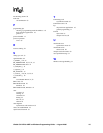
Global Call API for HMP on Windows Programming Guide — August 2006 147
device. Once the NCAS connection is established, the application can transmit user-to-user messages using the
CRN associated with the NCAS call.
Network Facility Associated Signal: See NFAS.
NFAS: Network Facility Associated Signaling; Allows multiple spans to be controlled by a single D channel
subaddressing.
Non-Call Associated Signal: See NCAS.
NSI: Network Specific Information message.
NT1: Network Terminator. The connector at either end of an ISDN link that converts the two-wire ISDN circuit
interface to four wires.
null: A state in which no call is assigned to the device (line or time slot).
overlap viewing: A condition of waiting for additional information about the called party number (destination
number).
preemptive multitasking: A form of multitasking wherein the execution of one thread or process can be
suspended by the operating system to allow another thread to execute. Windows uses preemptive multitasking to
support multiple simultaneous processes.
PRI: Primary Rate Interface. An interface at the ends of high-volume trunks linking CO facilities and ISDN
network switches to each other. A T1 ISDN PRI transmits 23 B channels (voice/data channels) and one D channel
(signaling channel), each at 64 Kbps. An E1 ISDN PRI transmits 30 B channels, one D channel and one framing
channel (synchronization channel), each at 64 Kbps. A standard digital telecommunication service, available in
many countries and most of the United States, that allows the transfer of voice and data over T1 or E1 trunks.
Primary Rate Interface: See PRI.
primary thread: See thread.
process (Windows): (1) an executing application comprising a private virtual address space, code, data and
other operating system resources, such as files, pipes and synchronization objects that are visible to the process. A
process contains one or more threads that run in the context of the process. (2) is the address space where the
sequence of executable instructions is loaded. A process in Windows consists of blocks of code in memory loaded
from executables and dynamically linked libraries (DLL). Each process has its own 4 GB address space and owns
resources such as threads, files and dynamically allocated memory. Code in the address space for a process is
executed by a thread. Each process comprises at least one thread which is the component that Windows actually
schedules for execution. When an application is launched, Windows starts a process and a primary thread. Windows
processes: 1). are implemented as objects and accessed using object services; 2). can have multiple threads
executing in their address space; 3). have built-in synchronization for both process objects and thread objects.
Unlike other operating systems, Windows does not use a parent/child relationship with the processes it creates.
PSI: Protocol State Information file used by the PDKRT to define a specific protocol.
PSTN: See Public Switched Telephone Network.



